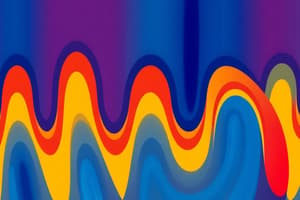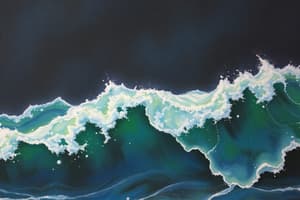Podcast
Questions and Answers
What happens when two waves of the same frequency and wavelength move through a medium in opposite directions?
What happens when two waves of the same frequency and wavelength move through a medium in opposite directions?
- They generate diffraction patterns
- They cause destructive interference
- They create a standing wave pattern (correct)
- They result in superposition
What is a key characteristic of waves that influences their behavior and observable properties?
What is a key characteristic of waves that influences their behavior and observable properties?
- Magnitude
- Frequency (correct)
- Volume
- Weight
What type of wave pattern results from the superposition of two or more waves?
What type of wave pattern results from the superposition of two or more waves?
- Diffraction pattern
- Interference pattern (correct)
- Standing wave pattern
- Refraction pattern
Which phenomenon involves the bending of waves around obstacles or edges?
Which phenomenon involves the bending of waves around obstacles or edges?
In normal waves, how do the oscillations occur in relation to the direction of wave propagation?
In normal waves, how do the oscillations occur in relation to the direction of wave propagation?
What occurs when two or more waves overlap in the same region of space?
What occurs when two or more waves overlap in the same region of space?
What is the distance between two consecutive identical points on a wave called?
What is the distance between two consecutive identical points on a wave called?
What is the term for the rate of propagation of a wave through a medium?
What is the term for the rate of propagation of a wave through a medium?
In normal waves, how do the particles (water molecules) oscillate in relation to the direction of wave propagation in surface water waves?
In normal waves, how do the particles (water molecules) oscillate in relation to the direction of wave propagation in surface water waves?
Which type of wave results from particles in the medium moving perpendicular to the wave's direction of travel?
Which type of wave results from particles in the medium moving perpendicular to the wave's direction of travel?
When two waves meet, what can happen to their amplitudes?
When two waves meet, what can happen to their amplitudes?
Which of the following influences the height of a wave?
Which of the following influences the height of a wave?
Flashcards are hidden until you start studying
Study Notes
General Wave Properties: Focus on Normal Waves
Waves are a fundamental form of energy transfer that permeate our daily lives, ranging from visible light to the hidden ripples of sound and ocean swells. In this article, we'll delve into the nature of waves, specifically focusing on the properties of normal waves, which are the most common and well-understood type of wave.
Wave Characteristics
At its core, a wave is a disturbance that propagates through a medium, transferring energy without a net transfer of matter. Key characteristics of waves include their amplitude (height), frequency (number of oscillations per time), wavelength (distance between two consecutive identical points), and velocity (rate of propagation through the medium). These characteristics influence the behavior and observable properties of waves, such as their appearance, interaction, and interference.
Normal Waves
Normal waves, also known as transverse waves, are waves in which the oscillations are perpendicular to the direction of wave propagation. These waves result from particles in the medium moving in a direction that is perpendicular to the wave's direction of travel. One common example of normal waves is light traveling through the air, where the particles oscillate perpendicular to the direction of light's propagation.
Other examples of normal waves include:
- Waves on a plucked string: When a string is plucked, waves travel along the string, causing the string to move up and down perpendicular to the direction of wave propagation.
- Electromagnetic waves: Electromagnetic waves, such as radio waves, microwaves, and visible light, involve the oscillation of electric and magnetic fields perpendicular to the direction of wave propagation.
- Water waves: Surface water waves, such as ripples on a pond, are examples of normal waves, with the particles (water molecules) oscillating perpendicular to the direction of wave propagation.
Wave Behavior
Normal waves exhibit predictable behaviors when they interact with each other or with other objects. For example, waves combine to form standing waves, superpositions, or interfere with each other to create a variety of patterns.
- Standing waves: When two waves of the same frequency and wavelength move through a medium in opposite directions, they create a standing wave pattern, where the particles oscillate at fixed positions.
- Superposition: When two or more waves overlap in the same region of space, they combine to form a sum of their individual amplitudes. This results in a new wave, the sum of the individual waves, and the total amplitude depends on the phase difference between the waves.
- Interference: When two waves meet, their amplitudes can either add or subtract (constructive or destructive interference), resulting in an altered wave pattern.
Wave Interference and Diffraction
Interference and diffraction are two related phenomena that are unique to waves, and they are particularly pronounced in normal waves due to their transverse nature.
- Interference: Interference occurs when two or more wavefronts overlap, causing the waves to combine in either a constructive or destructive manner. This results in patterns such as the bright and dark rings of a diffraction pattern or the characteristic patterns of a prism.
- Diffraction: Diffraction is the bending of waves around obstacles or edges. When waves encounter an obstacle, they can bend around the obstacle, resulting in a diffraction pattern. Diffraction is particularly evident in normal waves where the particles can move in all directions.
Conclusion
Normal waves, or transverse waves, are a common and important form of wave motion. They exhibit a variety of behaviors and phenomena, such as interference, diffraction, and superpositions, that make them fascinating to study. Understanding normal waves and their properties is essential for a wide range of fields, from physics and engineering to optics and communications. As we continue to explore the intricate dance of waves, we gain a deeper appreciation for the invisible forces that guide our world.
Studying That Suits You
Use AI to generate personalized quizzes and flashcards to suit your learning preferences.



